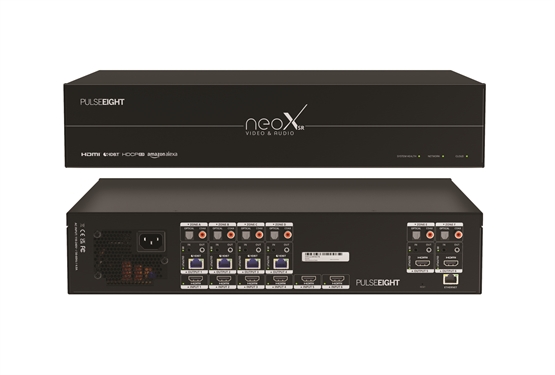
neo:XSR
Call us on 01202 413 610 (UK), (858) 748-8250 (US) or email sales@pulse-eight.com for more information
Extend 4K 60 4:4:4* up to 40 Meters and 1080p to 70 Meters over a single Cat6/7 cable
Core Features
- Ultra HD 4K 60 4:4:4* Video Transmission
- Full HDCP 2.2 Support
- 6x HDMI® 2.0 Inputs
- 4x HDBaseT 2.0 Class C (+DSC) Outputs
- 4x Ultra SR PoH Receivers Included
- 2x HDMI® 2.0 Outputs
- 6x Audio Outputs/Breakouts
- HDMI® Audio Return
- HDMI-CEC Bi-Directional Control
- Alexa Voice Control
- Bi-Directional IR Control
- Responsive Web Interface
- Automatic EDID Management
| Manufacturer: | Pulse-Eight |
| SKU: | P8-HDBT2-L-FFMJ66 |
The neo:XSR is a 6x6 HDMI®/HDBaseT video matrix switch and the perfect product for routing multiple 4K UHD source devices to multiple locations within your environment. Supporting HDMI® 2.0 a/b, the latest HDCP 2.3 and 18Gbps bandwidth this is a must-have product in any residential multi-room control system integrating with the latest 4K UHD media devices.
The Pulse-Eight neo:XSR Video & Audio Matrix has it all - with multiple video inputs and both video and audio outputs. Featuring 6 HDMI® inputs, 4 HDBaseT outputs and 2 HDMI® outputs alongside 6 audio output zones (with the options of Optical and Digital Coax). The neo:XSR goes the distance, supporting up to full 4K/60, 4:4:4, 8bit or 4K/60 4:2:2, 12bit up to 40 meters (130 feet). With audio breakout and support for multiple video control methods.
CEC - ULTIMATE SOURCE CONTROL
Imagine being able to control all of your devices (Sky, Blu-Ray Player, Apple TV etc) all from your original TV remote control... CEC control does just that. Gone are the days of 5 remote controls in one room and no need to buy any additional hardware such as universal remotes - you can do it all from your TV remote! Most TVs now support CEC and using our very own libCEC, we've baked that technology into the system. Now you can just use your normal TV remote and press the "Source" key, each of your input devices will be listed and just select the one you want and the matrix will route the video automatically, even if the source does not support CEC itself.
CONTEXTUAL IR
8 in, 10 out and multiple possible combinations of your video. Historically matrixes have offered remotes with 8 or 16 buttons, requiring multiple presses to get video to the TV your watching. We thought this was an odd solution, given you already known which room you are in, so should the matrix! Our designers eliminated this old concept and created Contextual IR, this reduces the number of buttons to just 8 - one for each possible input. Whatever room your in, select the output number and watch that source instantly.
RESPONSIVE WEB INTERFACE
We want to give you the best experience possible, to do this, we think it's important you can access the matrix from any device, be it mobile, tablet or desktop PC and in any browser. We've done this with our responsive design, so it works with you and not the other way round. Our web interface is built directly on top of our REST/API, this means that whatever you can do on your phone, you can get your control system to do also and vice versa. There are no hidden tricks or special codes that require a magic moon dance to work. All of our documentation is free and available on our monitoring site.
DSC (DISPLAY STREAM COMPRESSION)
At Pulse-Eight, we implement the latest technology into all of our systems and, with the demand for true 4K UHD displays, the neo:XSR incorporates DSC a VESA approved compression for low latency, visually lossless 4K video. DSC allows the neo:XSR to support 4K/60, 4:4:4, 8bit or 4K/60 4:2:2, 12bit without stripping out any of the 4K colour as per other compressions in the market.
HDMI® ARC (AUDIO RETURN CHANNEL)
Embedding HDMI-ARC technology into the neo:XSR and the included neo:Ultra Receivers, we have enabled the ability to utilise audio from the output source. HDMI-ARC is the perfect way to route audio from Smart TV’s in-built apps such as Netflix through the matrix and out of speakers attached to the neo:XSR’s digital audio outputs.
JUST ASK...
With the neo Alexa skill enabled on your Amazon Echo or Dot you can use commands to turn a certain TV on or off or to switch source devices. Imagine walking out of the lounge at night to continue watching TV in bed, you can simply say 'Alexa, turn off lounge' then 'Alexa, turn on Sky Q in bedroom' and without having to lift a finger the matrix will make your requests happen, including turning on the bedroom TV and switching to the input source with one command.
REMOTE MONITORING
It's important that you get video all the time, to help us do that your system keeps in contact with our cloud management service. You can tell if this is working with the Monitored LED on the front of the matrix. If you get stuck, your installer or yourself can log into our cloud portal and see helpful diagnosis information (if you let them), fix problems remotely or tell you where you may have gone wrong in the installation. All of this is free of charge. If the matrix has a problem, we get alerted too and we can get in contact to arrange a hardware replacement or give you a step by step guide to get you up and running again.